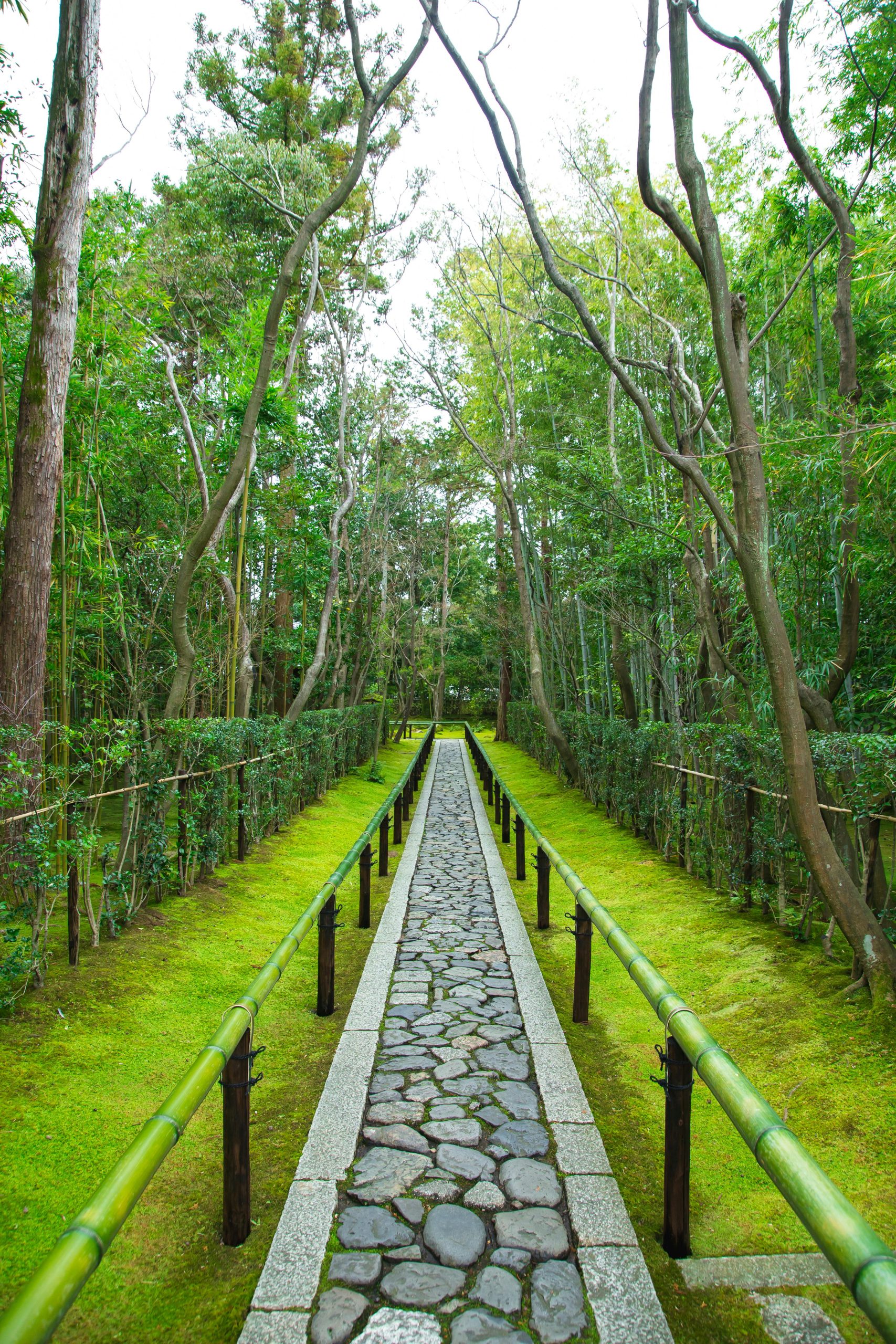Introduction to Zen Garden Design
Contents

What is a Zen Garden?
A Zen garden, or Karesansui, is a simple dry landscape made of natural elements like rock, gravel, and sand. These materials are arranged in patterns that reflect the essence of nature.
History and Cultural Significance
Zen gardens, which began in Japan during the late Kamakura period, were created to aid meditation. Monks carefully raked sand and gravel to mimic water ripples, fostering a sense of calm and introspection.
Benefits of Having a Zen Garden
Creating a Zen garden can turn your backyard into a peaceful retreat. It’s not just about looks; it’s about making a space where you can relax and clear your mind. Raking the gravel can help you focus and reduce stress, promoting mental clarity.
Planning Your Zen Garden

Understanding the Space and Its Potential
Every backyard can become a peaceful retreat. Start by evaluating the size, shape, and natural features of your outdoor area. Observe how sunlight moves across the space and the transition from indoors to outdoors. This initial assessment is essential for maximizing the potential of your Zen garden.
Basic Elements of Zen Garden Design
- Rocks and Stones: Represent mountains and islands, providing structure and focal points.
- Sand and Gravel: Raked to symbolize water, these elements add a sense of tranquility and movement.
- Plants: Simple yet significant, plants like moss or small shrubs introduce life and contrast.
Choosing a Theme or Style
Selecting a theme means matching your aesthetic preferences with Zen principles. Whether you prefer a traditional look with neatly raked gravel and striking rocks, or a modern approach with bamboo and ornamental grasses, the theme should balance simplicity and nature.
Preparing for Installation

Assessing Soil and Landscaping Needs
Before starting your project, thoroughly assess the soil. Knowing its composition is crucial for choosing the right plants and materials for your garden. Also, evaluate the current landscaping to see if any modifications are needed to fit your Zen design.
Tools and Materials Required
- Gravel Rake: Essential for creating precise patterns.
- Stones and Rocks: Fundamental elements of a Zen garden.
- Sand: Necessary for a smooth, flowing base.
Budgeting and Timeline Planning
Setting a budget early prevents unexpected costs and ensures a smooth process. Similarly, establishing a realistic timeline helps manage expectations and project flow. The simplicity of a Zen garden often leads to cost-effective and efficient installation.
Embrace Tranquility with a Japanese Garden Bridge
Imagine a gracefully arched bridge as the centerpiece of your serene Japanese garden. More than a passageway, it symbolizes transition and a journey towards enlightenment. The materials—whether aged wood or stone—reflect the timeless essence of nature.
Each bridge, whether arching over a koi pond or connecting secluded corners of your Zen retreat, is designed to maintain the garden’s aesthetic balance. The variety of these bridges, from the modest charm of a zigzag yatsuhashi to the bold elegance of a taiko-bashi painted in striking vermilion, is captivating.
Adding such a feature to your garden is an upgrade that invites introspection. As you cross this bridge, let it be a physical and metaphorical passage, reflecting the core tenets of Japanese philosophy.
Incorporating Fountains in Japanese Gardens
Imagine the soothing sound of water in your own garden. A fountain’s gentle murmur brings tranquility, its soft splashes a meditative rhythm. The Shishi-odoshi captivates with its rhythmic clack, adding a sense of peace and presence.
Fountains in Japanese gardens are more than just decoration; they are integral to the landscape. From simple bamboo to elegant carved stone, each fountain showcases nature’s artistry. Materials like granite and river rock blend seamlessly with the garden’s essence, creating a timeless and pure aesthetic.
Consider the placement. A fountain’s appeal is enhanced by its surroundings—nestled among evergreens or embraced by moss. It becomes a focal point, a beacon of serenity.
Envision the transformation. A fountain, whether surrounded by azaleas or adorned with pebbles, becomes the heart of a Zen garden. It is where peace resides and calm prevails.
Designing a Large Japanese Garden
Imagine a sanctuary where water, stone, and greenery converge in a symphony of natural beauty. A large Japanese garden is a canvas for such harmony, where grand ponds anchor the landscape’s soul. Graceful bridges curve across these tranquil waters, beckoning visitors to wander and discover.
Strategically placed pavilions provide respite, framing views that invite quiet reflection. The choreography of plants is key—trees sculpted with precision mirror the elegance of the architecture, while flowering shrubs punctuate the seasons with color. A carpet of moss offers a verdant tapestry, softening the garden’s footprint.
In crafting these expansive retreats, one weaves simplicity and elegance into every detail, honoring a profound reverence for nature.
- Grand Ponds Reflect the sky, teeming with koi, a centerpiece of calm.
- Graceful Bridges Span the water, connecting paths, inviting exploration.
- Pavilions Offer shelter, a place to pause, to breathe in the garden’s essence.
- Plant Arrangements Balance wildness and precision, seasonal hues against evergreens.
- Moss Carpets Soften the earth, a lush green against stone and water.
Enchanting Illumination: Floor Lights in Japanese Gardens
As twilight descends on the Japanese garden, floor lights come to life, transforming the space. These lights are more than fixtures; they guide visitors along paths and highlight the garden’s features. The garden, familiar by day, becomes a mystical landscape at night.
These lights serve a dual purpose: ensuring safe passage and enhancing the garden’s beauty. A stone lantern’s amber glow can reveal the texture of a mossy rock, while a hidden LED can illuminate the veins of a maple leaf.
Incorporate floor lighting into your Zen retreat for both visibility and aesthetic appeal.

- Pathway Highlights Direct soft beams to outline paths and guide the way.
- Feature Accents Use light to highlight the delicate interplay of leaves and water.
- Ambient Glow Choose fixtures that provide a gentle radiance, similar to moonlight.
Embracing Serenity: Pavilions in Japanese Gardens
Step into a Japanese garden pavilion, a haven of balance and calm. These structures, beyond mere shelters, are designed for reflection and leisure. The use of materials like wood or bamboo connects them with nature, and their placement is intentional to highlight the garden’s beauty.
Pavilions vary from the Azumaya, a rustic spot for quiet thought, to elegant tea houses for ceremonial matcha. They are strategically placed to overlook koi ponds or nestle among stones, offering views that integrate the garden’s elements. Add a pavilion to your Zen space to enhance your garden experience.
- Material Harmony Select natural wood or bamboo to echo the landscape.
- Strategic Placement Choose locations that frame the most stunning garden views.
- Design Diversity Opt for the Azumaya for simplicity or a tea house for elegance.
Embracing Serenity: The Pagoda in Japanese Gardens
Imagine a sanctuary where each element contributes to a symphony of tranquility. A pagoda, with its tiered silhouette, serves as a focal point in a Japanese garden. These structures, rooted in Buddhist tradition, represent the five elements—earth, water, fire, wind, and void.
Think of the pagoda as the centerpiece of your garden’s design. Its placement should be a deliberate pause in the landscape, encouraging reflection. Whether it’s the rustle of maple leaves or the glimmer of a koi pond at its base, the pagoda’s location is crucial to achieving Zen balance.
Each ascending tier draws your eyes upward while keeping your spirit grounded—a duality central to a Japanese garden. A pagoda is more than just a structure; it is a pathway to enlightenment, where form and spirit meet.
Enchanting Pathways in Japanese Gardens
Imagine a journey through tranquility, where each step invites you to be present. Japanese garden pathways are designed with intention, guiding you through a serene blend of nature and design. The choice of materials—stepping stones, fine gravel, or soft moss—reflects the earth’s colors, harmonizing with the lush greenery.
These pathways are not random; they are nature’s own artwork. Irregular shapes and thoughtful placements mimic a forest floor, a deliberate design that slows your pace and deepens your contemplation. With every turn, a new scene unfolds, capturing the essence of Zen.
Envision your backyard transformed, a space where bamboo whispers and azaleas nod along your path. It’s an environment that does more than please the eye—it’s a sanctuary for the soul.
Integrating these elements into your own space is not just about beauty. It’s about creating an atmosphere that invites calm and introspection into your daily life. A Japanese garden pathway is more than a route; it’s a passage to peace.
Embrace Tranquility with Japanese Garden Plants
Step into a space where plants tell the ancient stories of Japan. Cherry blossoms bloom gracefully, reminding us of life’s fleeting moments. Japanese maples light up the autumn landscape with vibrant colors, showcasing nature’s dynamic beauty.
Sturdy pines stand tall, symbolizing strength and resilience. The ‘niwaki’ pruning technique shapes these trees into living sculptures, reflecting the grandeur of natural landscapes.
Picture a lush carpet of moss, offering a serene green backdrop, and bamboo stalks swaying gently in the breeze, creating a peaceful atmosphere. These elements form the harmonious composition of a Japanese garden.
Incorporating these plants into your garden creates a tranquil retreat, blending beauty with a sense of calm.
The Art of Stones in Japanese Gardens
In Japanese garden design, rocks serve as the foundation of natural artistry. Carefully selected for their shape, texture, and color, these stones are arranged to create a balanced and harmonious environment. Rocks in a Japanese garden symbolize elements like mountains, islands, or animals, reflecting Zen philosophy.
Placing stones is a deliberate process, engaging with nature. Each rock’s position is intentional, contributing to the garden’s tranquility. From moss-covered boulders grounding the landscape to smooth pebbles lining water features, every stone has a purpose. They guide energy, draw attention, and provide a focal point.
Incorporate this ancient practice into your own space to create a peaceful retreat. Mastering stone placement invites a connection with nature, offering a Zen sanctuary where harmony is evident in every view.
Streamlined Serenity: Japanese Garden Streams
Imagine a sanctuary where water flows gently and leaves sway, creating a peaceful atmosphere. In Japanese gardens, streams are central, bringing a sense of Zen to every part. A well-placed stream draws the eye and spirit into a reflective journey, its path meandering naturally, bordered by stones and pebbles that mimic the untamed beauty of nature.
Each stream tells a unique story, blending seamlessly into its environment. It could be a gentle brook alongside a green path or a quiet stream flowing under an elegant moon bridge. These water features are not just visually appealing; they are the core of a tranquil landscape.
Choosing materials is a careful process, ensuring both authenticity and durability. Granite, river stones, and bamboo are popular choices, valued for their lasting quality and natural look.
- Authenticity is achieved through the careful selection of materials that reflect the natural world.
- Durability ensures that the serene beauty of your garden stream endures over time.
- Integration is crucial, as the stream must harmonize with the garden’s existing elements.
Embrace Tranquility with Zen Garden Sand Patterns
Discover the minimalist beauty and profound calm of a Zen garden. At its core, the sand patterns invite mindfulness. These raked designs are not just art; they reflect life’s ebb and flow, embodying stillness and movement.
Consider the ripple effect. Each line, each curve in the sand mirrors the impact of our actions on the universe. Straight lines create a path of serenity, while intricate swirls represent life’s constant motion. The process of raking—deliberate and unhurried—becomes a meditative practice, grounding the spirit.
Imagine transforming your space into a haven of peace. A Zen garden with its sand patterns is more than an aesthetic choice; it’s a commitment to harmony. Here, amidst the whisper of sand grains, stress fades, and one’s connection to nature deepens.
Integrating Pavers into Your Japanese Garden
Imagine a path that meanders, guiding you through a tranquil landscape. In Japanese garden design, pavers lead you step by step into a world of Zen. They are not just functional; they are integral to the garden’s essence.
Choose pavers that blend seamlessly with nature. Natural stone, slate, or weathered wood—each piece contributes to the harmony of your garden. Their colors and textures should be subtle yet impactful, reflecting the calm of the earth.
The arrangement of pavers requires precision and thoughtfulness. Each stone, slightly askew, invites you to slow down and appreciate the journey. This deliberate placement encourages mindfulness and connection.
With every paver you set, you’re creating more than just a pathway; you’re crafting an experience. It’s a sensory journey that grounds you in the present, surrounded by rustling bamboo and soft moss.

In Closing
Transform your backyard into a peaceful retreat with the simple elegance of Zen garden design. By incorporating natural elements like rocks, sand, and plants, you can create a space that enhances both aesthetic appeal and mindfulness. These gardens exemplify the balance between natural beauty and intentional landscaping, providing a sanctuary from the busy world outside. Consider these design principles to bring calm and reflection into your daily life, making your home a more tranquil place.
